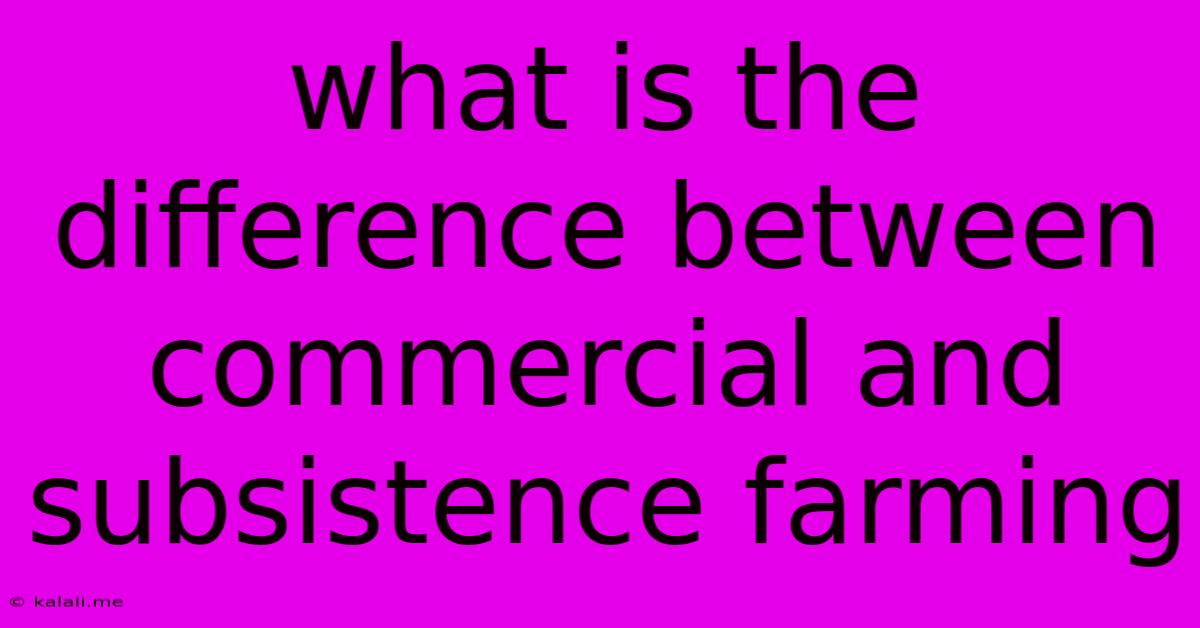What Is The Difference Between Commercial And Subsistence Farming
Kalali
Jun 12, 2025 · 3 min read

Table of Contents
Commercial vs. Subsistence Farming: A Comprehensive Comparison
Understanding the difference between commercial and subsistence farming is crucial for comprehending global food systems and agricultural economies. While both involve cultivating land for food production, their motivations, scales, and impacts differ significantly. This article will delve into the key distinctions between these two fundamental farming approaches. This comparison will help you grasp the nuances of each system and their roles in shaping our world.
What is Commercial Farming?
Commercial farming, also known as intensive farming or industrial agriculture, prioritizes profit maximization. It's characterized by large-scale operations focused on producing high yields of a single crop or livestock breed for sale in a market. Efficiency and profitability are paramount, often utilizing advanced technologies and economies of scale. Think large-scale monoculture plantations or massive livestock feedlots.
Key Characteristics of Commercial Farming:
- Large-scale operations: Covers extensive land areas and employs significant labor or machinery.
- High yields: Emphasizes maximizing output per unit of land or animal.
- Market orientation: Production is geared towards satisfying consumer demand in local or global markets.
- Specialization: Often focuses on a single crop (e.g., wheat, corn, soybeans) or livestock (e.g., poultry, cattle).
- Technology-intensive: Utilizes advanced technologies like machinery, irrigation systems, fertilizers, and pesticides.
- Capital-intensive: Requires substantial investment in land, equipment, and technology.
- Potential for environmental impact: Intensive farming practices can lead to soil degradation, water pollution, and biodiversity loss.
What is Subsistence Farming?
Subsistence farming is a traditional agricultural practice where farmers cultivate enough food to feed themselves and their families, with little or no surplus for sale. It's often characterized by small-scale operations using simple tools and traditional techniques. Sustainability and self-sufficiency are the primary goals. This type of farming is common in many developing countries.
Key Characteristics of Subsistence Farming:
- Small-scale operations: Typically involves small plots of land cultivated by a family or small community.
- Low yields: Focus is on providing for basic needs rather than maximizing output.
- Self-sufficiency: Production primarily serves the farmer's household and local community.
- Diversified crops: Often involves growing a variety of crops to ensure food security and reduce risk.
- Labor-intensive: Relies heavily on manual labor with limited use of technology or machinery.
- Low capital investment: Requires minimal financial investment in land, tools, and technology.
- Sustainable practices (often): Traditional techniques may include crop rotation, intercropping, and natural pest control methods.
Comparing Commercial and Subsistence Farming: A Table Summary
| Feature | Commercial Farming | Subsistence Farming |
|---|---|---|
| Scale | Large-scale | Small-scale |
| Goal | Profit maximization | Self-sufficiency |
| Market | Market-oriented | Primarily for household consumption |
| Technology | High-tech, mechanized | Labor-intensive, traditional methods |
| Yield | High | Low |
| Specialization | Specialized crops or livestock | Diversified crops and livestock |
| Capital | High capital investment | Low capital investment |
| Environmental Impact | Potentially high environmental impact | Generally lower environmental impact |
Conclusion:
The distinction between commercial and subsistence farming highlights a fundamental contrast in agricultural approaches. While commercial farming drives food production for global markets, often at the cost of environmental sustainability, subsistence farming prioritizes self-sufficiency and sustainable practices within a local context. Understanding these differences is key to developing effective and equitable agricultural policies and ensuring food security for all. The future of agriculture will likely involve a blend of both approaches, striving for efficiency while prioritizing sustainability and addressing global food challenges.
Latest Posts
Latest Posts
-
Which Of The Following Are Only Found In Animal Cells
Jun 13, 2025
-
What Is Square Root Of 125
Jun 13, 2025
-
What Is Full Form Of Email
Jun 13, 2025
-
A 32 Bit Word Computer Can Access
Jun 13, 2025
-
Differentiate Between Subsistence Agriculture And Commercial Agriculture
Jun 13, 2025
Related Post
Thank you for visiting our website which covers about What Is The Difference Between Commercial And Subsistence Farming . We hope the information provided has been useful to you. Feel free to contact us if you have any questions or need further assistance. See you next time and don't miss to bookmark.